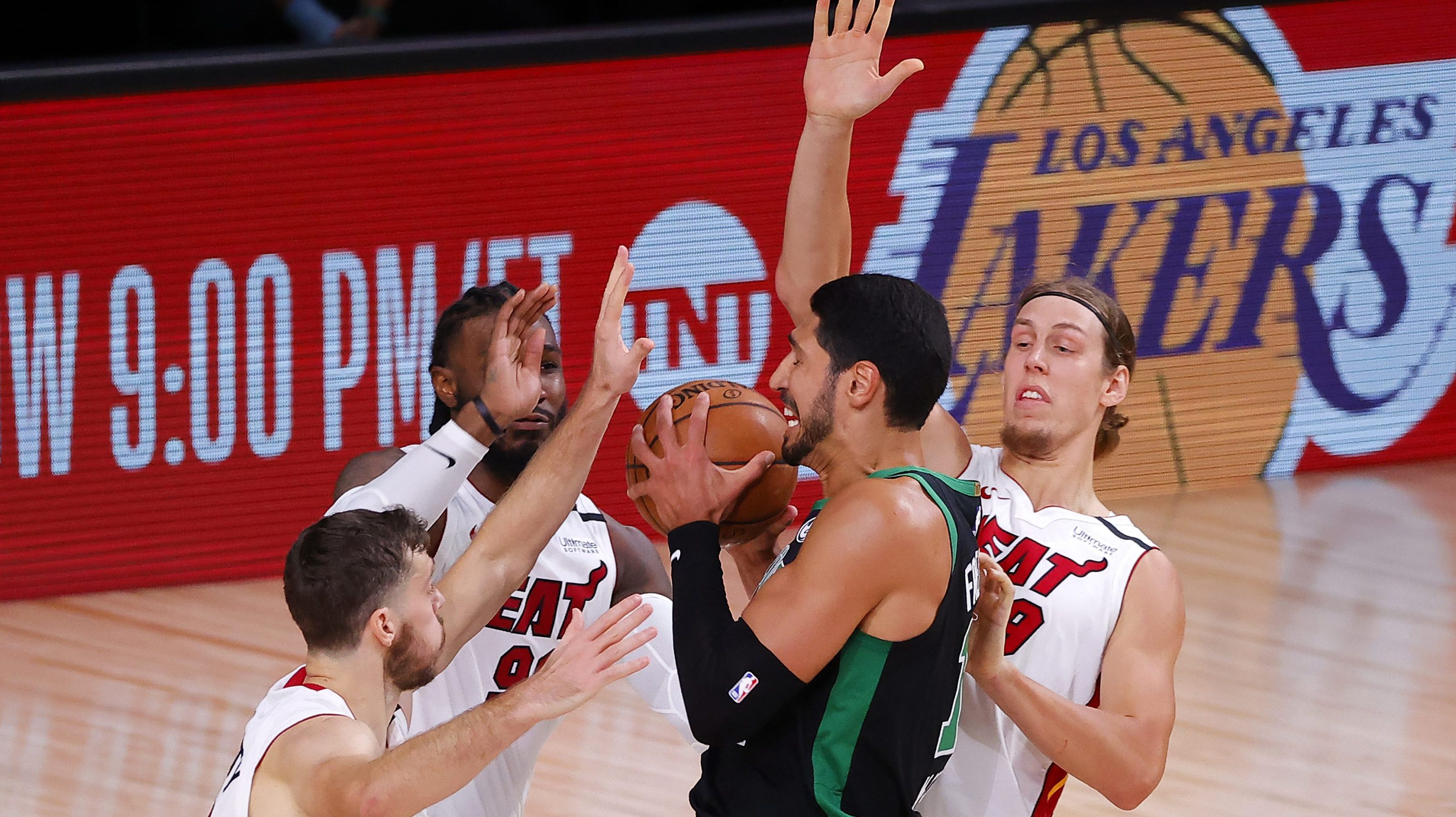There are many reasons why the Boston Celtics blew a 17-point lead in Game 2 of the Eastern Conference Finals against the Miami Heat, and why they now face an 0-2 deficit. Heat wing Duncan Robinson shook off his recent shooting slump to go 6-of-12 from three-point land. Bam Adebayo absolutely dominated the paint on offense, scoring 15 of his 21 points in a key 37-point third quarter for Miami. Goran Dragic continued to play like the best point guard in the series, finishing with 25 points. Jimmy Butler came up with a handful of clutch plays again, just as he did in Game 1.
The biggest reason for the Celtics' collapse, however, was Heat coach Erik Spoelstra's decision to double down on what is, in theory, a basic basketball defense, practiced by high school teams with out of shape players across the country: the 2-3 zone. After not playing the zone at all in the first two rounds of playoffs against the Indiana Pacers and the Milwaukee Bucks, Spoelstra had Miami revert to it in Game 1 for 14 possessions, and in Game 2 for a whopping 32. Though Boston had some success with their shot-making against the zone in the first game, scoring 16 points in those 14 possessions, Spoelstra stuck with the scheme in Game 2, and it paid off big as Miami roared back on Thursday night. According to Heat reporter Couper Moorhead, the Celtics scored 25 points on those 32 possessions, for a disastrous 0.78 points per possession.
These struggles aren't particularly new for Boston. In their second-round series against the Raptors, their offense took a noticeable nosedive against Toronto's creative zone schemes. Per NBA.com, the Celtics scored 109.2 points per 100 possessions against man-to-man defense in that series, but only 90.3 possessions per 100 possessions against the zone. The Raptors use stranger zone packages (such as the box-and-one and 3-2) than Miami, who sticks to the 2-3 almost exclusively, but the same concept applies. It also helps the Heat that even in their man-to-man defense, they switch on almost every ball screen, mimicking zone concepts even as they don't strictly play the 2-3. Why does it work, and why can Boston seemingly not crack it?
Miami's personnel is a big reason. The Heat have more than their fair share of rangy, long wings who can converge on the open shooters that the zone gives up, purposefully. The 2 in the 2-3 are usually Jimmy Butler and Jae Crowder, who can guard Kemba Walker and Jayson Tatum, while the rotating cast of guards stick to the corners, collapsing in when the Celtics attempt to prod the paint. This also allows Miami to hide some negative defenders, like Robinson and Dragic, with the knowledge that there will always be defenders behind them if the Celtics try to initiate offense from the corners.
Though Boston has gotten open looks on the wings against the zone, more often than not, their open shooters' space disappears as the forwards converge, forcing Boston to try to drive in instead. YouTuber Half Court Hoops broke down the zone's effectiveness following Game 2, highlighting the Butler-Crowder duo's mobility as a way to combat any sort of screening action, shutting down Boston's ability to gain momentum as they try to enter the paint.
Even when they do get by the top of the zone, Boston plays right into the 2-3's strengths, particularly when Bam Adebayo is in the middle of the 3. Miami used the zone extensively in the second half (29 of 32 zone possessions came after halftime), and in turn, Boston's points-in-the-paint production dropped from 32 in the first half to just 14 in the second. If Boston isn't making their shots from behind the arc—10-of-28 for the game—and if they can't score in the paint, the game becomes a lot tougher to win, particularly while they miss Gordon Hayward due to injury; one can imagine that Mr. Education Reform would be a strong tool against the zone, with his ability to hit midrange shots in between Miami's swarming perimeter recoveries and paint supremacy.
Special credit has to go to Butler, who turned it up, as he has done throughout the playoffs, in the fourth quarter, sprinting around the top of the zone with active hands, leading to three steals that throttle Boston's momentum late in the game.
With defenders like Butler, Crowder, and Derrick Jones Jr. (who got more run in Game 2, and should likely keep stealing most of Kendrick Nunn's minutes), the Heat are able to completely nullify the biggest advantage NBA offenses have running up against a zone. Combine that with Adebayo's offensive dominance and Robinson's potential re-discovery of his shooting, and Boston had no answers for Miami in the second half.
There's not much in the way of personnel changes that Celtics coach Brad Stevens can do about that (though he will likely not play Enes Kanter, a human turnstile, as often), and his postgame comments, whether honest or not, seem to hint at resignation towards the zone, focusing instead of his own players' quality, rather than the scheme they're facing:
Miami has no reason to abandon the zone until the Celtics come up with a reason for them to do so. Stevens can deflect attention onto his own team's shortcomings as much as he wants, but at some point he's going to have to figure out how to crack the same gimmicky defense that high school coaches around the country have been able to solve.






